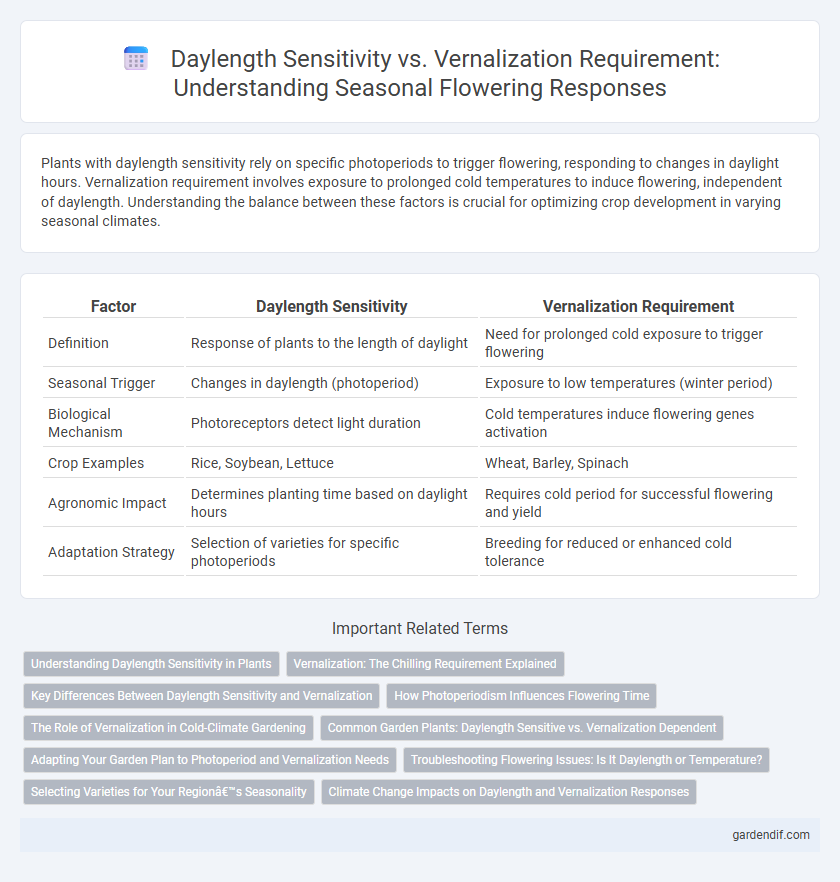
Daylength sensitivity vs Vernalization requirement Illustration
Plants with daylength sensitivity rely on specific photoperiods to trigger flowering, responding to changes in daylight hours. Vernalization requirement involves exposure to prolonged cold temperatures to induce flowering, independent of daylength. Understanding the balance between these factors is crucial for optimizing crop development in varying seasonal climates.
Table of Comparison
| Factor | Daylength Sensitivity | Vernalization Requirement |
|---|---|---|
| Definition | Response of plants to the length of daylight | Need for prolonged cold exposure to trigger flowering |
| Seasonal Trigger | Changes in daylength (photoperiod) | Exposure to low temperatures (winter period) |
| Biological Mechanism | Photoreceptors detect light duration | Cold temperatures induce flowering genes activation |
| Crop Examples | Rice, Soybean, Lettuce | Wheat, Barley, Spinach |
| Agronomic Impact | Determines planting time based on daylight hours | Requires cold period for successful flowering and yield |
| Adaptation Strategy | Selection of varieties for specific photoperiods | Breeding for reduced or enhanced cold tolerance |
Understanding Daylength Sensitivity in Plants
Daylength sensitivity in plants refers to their ability to detect and respond to changes in photoperiod, which influences flowering and growth cycles. This adaptation ensures reproductive events align with optimal environmental conditions, enhancing survival and yield. Unlike vernalization, which requires prolonged cold exposure to induce flowering, daylength sensitivity depends solely on the length of daylight, making it critical for seasonal timing in diverse ecosystems.
Vernalization: The Chilling Requirement Explained
Vernalization is the process by which certain plants require exposure to prolonged cold temperatures to initiate flowering, ensuring proper seasonal development. This chilling requirement enables plants like winter wheat and biennial crops to synchronize growth cycles with favorable conditions. Understanding vernalization helps optimize planting schedules and improves crop yield by aligning flowering time with environmental cues.
Key Differences Between Daylength Sensitivity and Vernalization
Daylength sensitivity refers to a plant's response to the length of daylight, triggering flowering when a specific photoperiod is reached, whereas vernalization requirement involves exposure to prolonged cold to induce flowering. Key differences include that daylength sensitivity is primarily influenced by light duration, affecting short-day or long-day plants, while vernalization depends on low temperature exposure to break dormancy. These mechanisms ensure plants flower at optimal seasonal times, enhancing reproductive success.
How Photoperiodism Influences Flowering Time
Photoperiodism directly influences flowering time by triggering developmental changes when plants detect specific daylength thresholds, ensuring flowering occurs under optimal seasonal conditions. Long-day plants flower when daylight exceeds a critical length, while short-day plants initiate flowering as daylength decreases below a set duration. This sensitivity allows plants to synchronize reproductive phases with seasonal environmental cues, maximizing reproductive success.
The Role of Vernalization in Cold-Climate Gardening
Vernalization plays a crucial role in cold-climate gardening by enabling certain plants to flower after exposure to prolonged cold temperatures, ensuring their life cycles align with seasonal changes. This cold-induced process complements daylength sensitivity, which relies on photoperiod cues to regulate flowering time, but vernalization specifically triggers flowering in species that require chilling periods. Understanding vernalization requirements helps gardeners select and time crops such as winter wheat, biennial vegetables, and perennial flowers to optimize growth and yield in cold environments.
Common Garden Plants: Daylength Sensitive vs. Vernalization Dependent
Common garden plants exhibit distinct seasonal adaptations characterized by daylength sensitivity or vernalization requirements. Daylength-sensitive species, such as chrysanthemums and spinach, initiate flowering based on specific photoperiods, optimizing growth in response to seasonal light changes. In contrast, vernalization-dependent plants like tulips and winter wheat require prolonged cold exposure to trigger flowering, ensuring reproductive success after winter dormancy.
Adapting Your Garden Plan to Photoperiod and Vernalization Needs
Daylength sensitivity influences plant flowering by responding to the length of daylight, determining optimal planting times for short-day or long-day species. Vernalization requirement involves exposing plants to a prolonged cold period to trigger flowering, essential for crops like wheat and carrots. Adapting garden plans to these factors ensures successful growth cycles by matching plant-specific photoperiod and vernalization needs with local seasonal conditions.
Troubleshooting Flowering Issues: Is It Daylength or Temperature?
Flowering disruptions often hinge on daylength sensitivity or vernalization requirements, with photoperiod-sensitive plants needing specific light durations for transition to bloom, while vernalization-dependent species require prolonged cold exposure to initiate flowering. Identifying whether flowering delay stems from inadequate daylight hours or insufficient chilling temperatures is key to troubleshooting crop performance and timing. Tailoring cultivation practices such as adjusting planting dates or using environmental controls can effectively resolve flowering issues linked to these seasonal physiological triggers.
Selecting Varieties for Your Region’s Seasonality
Daylength sensitivity and vernalization requirement are critical factors when selecting crop varieties suited to your region's seasonality. Varieties with specific photoperiod sensitivity align flowering and development stages with optimal daylight lengths, ensuring maximum yield. Matching vernalization needs with local winter temperatures guarantees proper flowering timing, enhancing crop adaptation and productivity.
Climate Change Impacts on Daylength and Vernalization Responses
Climate change alters daylength sensitivity and vernalization requirements by shifting temperature patterns and seasonal cues, impacting plant developmental cycles. Warmer winters reduce vernalization fulfillment, delaying flowering in crops reliant on cold exposure, while changing photoperiods disrupt daylength-triggered growth stages. These shifts challenge agricultural productivity and ecosystem stability by affecting phenology, yield timing, and species interactions in temperate regions.
Daylength sensitivity vs Vernalization requirement Infographic

 gardendif.com
gardendif.com